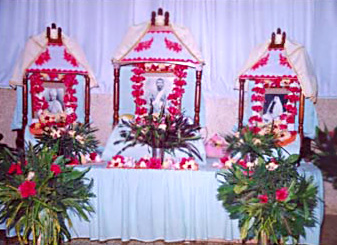 Modern Mathas of Puri have sprung up in great numbers. Besides the early Mathas of the land which were mostly associated with the Jagannath Temple of Puri, the mathas of recent origin have diversified into a number of other functions. Some of the recent Mathas of Puri are the ones which believe in all the sects and there are also some Mathas which do not believe in any sect, the Ram Krishna Mission, the Bharat Sevasram Sangha and the Mathas which are founded by several communities.
Modern Mathas of Puri have sprung up in great numbers. Besides the early Mathas of the land which were mostly associated with the Jagannath Temple of Puri, the mathas of recent origin have diversified into a number of other functions. Some of the recent Mathas of Puri are the ones which believe in all the sects and there are also some Mathas which do not believe in any sect, the Ram Krishna Mission, the Bharat Sevasram Sangha and the Mathas which are founded by several communities.
Matha believing in all sects or Non-sect Mathas
There are certain Mathas established in the nineteenth century which are not affiliated to any sect. These Mathas are: l.Abadhuta, 2. Jogada, 3. Satyaprakash and 4.Girinari. The Abadhuta Matha was founded, by a saint namely Pagal Baba jointly with a religious minded person namely Hari Muduli; Jogada Math by the members of Women`s Educational Centre , Satyaprakash Matha by Satyarsi Jogajibanananda; and Girinari Matha by a saint namely Digambara Baba. All these Mathas represent assembly of all doctrines and philosophical principles of all sects (Sarba Dharma) Samanwaya and have nothing to do with the religious functions of the temple.
Ram Krishna Mission
Ramakrishna Mission has set up a Matha which is called Ram Krishna Matha in the twentieth century. Whenever any swami of the Mission visits Puri he stays at this Matha. Except providing accommodation to the Sanyasis of the Mission the Matha has no other functions to perform in the ritual set up of the temple.
Bharat Sevashram Sangha
Bharat Sevashram Sangha has a branch at Puri. It does not preach any religious doctrine. It professes Sanatan Dharama. Those who visit Puri on pilgrimage and to have darsan of Lord Jagannath can stay at this place for three days. It is a sort of lodging house having no ritual relationship with the temple.
Mathas founded by various communities
Some castes have monasteries of their own at Puri. For example, the weaver caste namely Patra has its own Matha which is called Kapadia or Tanti or Patara Matha. It is affiliated to Ramanandi sect and is in existence since the nineteenth century. Whenever persons belonging to this caste come on a visit to Puri they stay in this Matha which appears to have no ritual significance except for providing rent free lodging to the people of Patara caste.
Similarly the All Orissa Barbers Association has established a Matha called Jada Matha in Puri and affiliated it to the Goudwa Madhva sect. It is there since the eighteenth century. Like the Patara Matha no ritual function is assigned to the Jada Matha and it has only to provide accommodation to the pilgrims of Barber caste during their visit to Puri on festive occasions.
Unlike the above mentioned two castes-specific Mathas like Khilor Matha which was set up in the Kunddaibent street around seventeenth century was of the people of Khilor, a multi-caste village situated near Khurda Road of Puri District. It is not affiliated to any sect and its function is that of a lodging house.



















